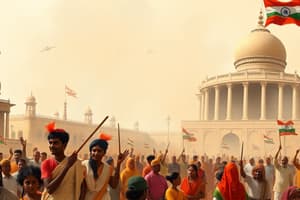Podcast
Questions and Answers
Which strategy was primarily employed by the early phase leaders of the Indian National Movement, as mentioned in the song?
Which strategy was primarily employed by the early phase leaders of the Indian National Movement, as mentioned in the song?
- Using violence and revolutionary tactics to overthrow British rule.
- Forming alliances with other nations to gain military support against the British.
- Employing the '3Ps'—Post, Petition, and Press—to appeal to the British Queen's sense of justice. (correct)
- Organizing mass protests and boycotts of British goods.
How did the Radical phase of the Indian National Movement, characterized by leaders like Lal-Bal-Pal, differ from the approach of the early phase leaders?
How did the Radical phase of the Indian National Movement, characterized by leaders like Lal-Bal-Pal, differ from the approach of the early phase leaders?
- The Radicals prioritized petitioning the British government, while the early phase focused on violent revolt.
- The Radicals focused on elite-only recruitment while the early phase involved the masses.
- The Radicals promoted aggressive methods such as boycotts and emphasized self-rule, contrasting with the early phase's moderate appeals. (correct)
- The Radicals advocated for maintaining close ties with the British monarchy.
What was the primary objective of the Home Rule Movement led by Tilak and Besant during World War I?
What was the primary objective of the Home Rule Movement led by Tilak and Besant during World War I?
- To advocate for complete independence from British rule through violent means.
- To support the British war effort in exchange for minor concessions.
- To establish separate electorates for Muslims to ensure their political representation.
- To mobilize support for self-government within the British Empire through speeches and plays. (correct)
What was the significance of the Lucknow Pact in the context of the Indian National Movement?
What was the significance of the Lucknow Pact in the context of the Indian National Movement?
How did the British policy of 'Divide & Rule' impact the Indian National Movement, as hinted in the song?
How did the British policy of 'Divide & Rule' impact the Indian National Movement, as hinted in the song?
Which principles formed the foundation of Gandhi's Satyagraha philosophy, as highlighted in the lyrics?
Which principles formed the foundation of Gandhi's Satyagraha philosophy, as highlighted in the lyrics?
Besides non-violent resistance, what other social reforms did Gandhiji advocate for as part of the Indian National Movement?
Besides non-violent resistance, what other social reforms did Gandhiji advocate for as part of the Indian National Movement?
What does 'Swaraj' signify in the context of the Indian National Movement?
What does 'Swaraj' signify in the context of the Indian National Movement?
How did the emphasis on 'Swadeshi' contribute to the Indian National Movement, according to the song?
How did the emphasis on 'Swadeshi' contribute to the Indian National Movement, according to the song?
How did Gandhi's experiences in South Africa influence his approach to the Indian National Movement?
How did Gandhi's experiences in South Africa influence his approach to the Indian National Movement?
Flashcards
Moderates
Moderates
Early nationalists who used methods like petitions and press to advocate for reforms.
Radicals
Radicals
Advocated for Swaraj (self-rule) and used methods like boycotts and revival of Indian industries.
Home Rule Movement
Home Rule Movement
Movement during World War I advocating for self-government within the British Empire.
Lucknow Pact
Lucknow Pact
Signup and view all the flashcards
Divide & Rule
Divide & Rule
Signup and view all the flashcards
Satyagraha
Satyagraha
Signup and view all the flashcards
Swadeshi Movement
Swadeshi Movement
Signup and view all the flashcards
Harijans
Harijans
Signup and view all the flashcards
Study Notes
- The song encapsulates the Indian National Movement.
Early Phase
- Dominated by Western-suited elites with a small recruitment base.
- Notable figures included Pherozshah, Dadabhai, and Gokhale.
- Tactics revolved around the "3Ps": Post, Petition, and Press.
- Sought justice and freedom via appeals to the Queen.
Radical Phase
- Radicals criticized the Moderates for their slow pace.
- Lal-Bal-Pal (Lala Lajpat Rai, Bal Gangadhar Tilak, Bipin Chandra Pal) popularized Swadeshi.
- Advocated for boycott, revival, and national pride.
- Demanded Swaraj, meaning self-rule.
Home Rule Movement
- Took place around 1916, during World War I.
- Home Rule Leagues aimed to realize the dream of freedom.
- Tilak and Besant utilized speeches and plays to spread their message from Delhi to Kolkata.
Lucknow Pact
- Marked a moment of unity between Muslims and Hindus against British rule.
- Separate electorates were accepted temporarily.
- Focused on achieving dominion status.
Divide & Rule
- A British strategy that aimed to divide communities.
- Evident in the partition of Bengal, which created a communal environment.
- The Muslim League was formed in 1906.
- Nawab and Aga Khan were significant figures in the League.
Gandhiji’s Fire
- Gandhi was born in Porbandar.
- Developed Satyagraha in response to his experiences in South Africa.
- Satyagraha is based on truth and peace, advocating for non-violent resistance.
Gandhiji’s Reforms
- Focused on boycotting British goods and promoting Swadeshi through spinning.
- Advocated for the upliftment of "Untouchables," renaming them Harijans.
- Promoted women's leadership roles.
Studying That Suits You
Use AI to generate personalized quizzes and flashcards to suit your learning preferences.




